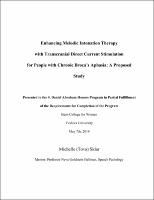Please use this identifier to cite or link to this item:
https://hdl.handle.net/20.500.12202/4510Full metadata record
| DC Field | Value | Language |
|---|---|---|
| dc.contributor.advisor | Hellman, Neva Goldstein | en_US |
| dc.contributor.author | Sklar, Michelle (Tova) | |
| dc.date.accessioned | 2019-07-10T17:55:46Z | |
| dc.date.available | 2019-07-10T17:55:46Z | |
| dc.date.issued | 2019-05-07 | |
| dc.identifier.citation | Sklar, Michelle Tovah. Enhancing Melodic Intonation Therapy with Transcranial Direct Current Stimulation for People with Chronic Broca’s Aphasia: A Proposed Study Presented to the S. Daniel Abraham Honors Program in Partial Fulfillment of the Requirements for Completion of the Program Stern College for Women Yeshiva University May 7th, 2019 | en_US |
| dc.identifier.uri | https://hdl.handle.net/20.500.12202/4510 | |
| dc.identifier.uri | https://ezproxy.yu.edu/login?url=https://repository.yu.edu/handle/20.500.12202/4510 | |
| dc.description | The file is restricted for YU community access only. | en_US |
| dc.description.abstract | The neural mechanisms underlying the success of Melodic Intonation Therapy (MIT) are heavily debated. Several studies report that MIT increases language production by recruiting the right Broca’s homolog through speaking in a sing-song tune, while others find that MIT promotes greater left-hemisphere activation. Stage in recovery (subacute vs. chronic) has been reported to influence the lateralization of language processing. Understanding which areas are responsible for language recovery during therapy is crucial when attempting to enhance the therapy by electrically stimulating specific neural regions. This research proposal investigates whether applying transcranial direct current stimulation (tDCS) to the left hemisphere, as opposed to the right hemisphere, will greater enhance MIT among people with chronic Broca’s aphasia. One group will receive tDCS on the right side of the brain, one will receive tDCS on the left side of the brain, and a control group receiving sham tDCS, all while undergoing MIT. Various language tasks and resting-state functional magnetic resonance imaging will assess the impacts of tDCS combined with MIT on language production and neural activation. | en_US |
| dc.description.sponsorship | S. Daniel Abraham Honors Program of Stern College for Women | en_US |
| dc.language.iso | en_US | en_US |
| dc.publisher | Stern College for Women Yeshiva University. | en_US |
| dc.rights | Attribution-NonCommercial-NoDerivs 3.0 United States | * |
| dc.rights.uri | http://creativecommons.org/licenses/by-nc-nd/3.0/us/ | * |
| dc.subject | senior honors thesis | en_US |
| dc.subject | Chronic Broca’s Aphasia | en_US |
| dc.subject | proposed study | en_US |
| dc.subject | Melodic Intonation Therapy (MIT) | en_US |
| dc.subject | Transcranial Direct Current Stimulation (tDCS) | en_US |
| dc.subject | fMRI | en_US |
| dc.title | Enhancing Melodic Intonation Therapy with Transcranial Direct Current Stimulation for People with Chronic Broca’s Aphasia: A Proposed Study. | en_US |
| dc.type | Thesis | en_US |
| Appears in Collections: | S. Daniel Abraham Honors Student Theses | |
Files in This Item:
| File | Description | Size | Format | |
|---|---|---|---|---|
| Tova Sklar Thesis (1).pdf Restricted Access | The file is restricted for YU community access only. | 266.03 kB | Adobe PDF |  View/Open |
This item is licensed under a Creative Commons License

